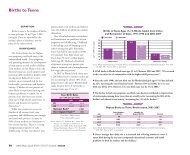2010 Rhode Island Kids Count Factbook
2010 Rhode Island Kids Count Factbook
2010 Rhode Island Kids Count Factbook
Create successful ePaper yourself
Turn your PDF publications into a flip-book with our unique Google optimized e-Paper software.
Children Receiving Child Support<br />
DEFINITION<br />
Children receiving child support is the<br />
percentage of parents who make child<br />
support payments on time and in full as<br />
indicated in the <strong>Rhode</strong> <strong>Island</strong> Office of<br />
Child Support Services system. The<br />
percentage does not include cases in<br />
which paternity has not been established<br />
or cases in which the non-custodial<br />
parent is not under a court order<br />
because he/she cannot be located. Court<br />
orders for child support and medical<br />
support require establishment of<br />
paternity.<br />
SIGNIFICANCE<br />
Child support is a major part of the<br />
safety net for children and families.<br />
One in four U.S. children (17 million)<br />
receives child support services. 1 Child<br />
support provides a mechanism for noncustodial<br />
parents (usually fathers) to<br />
contribute to the financial and medical<br />
support of their children. Child support<br />
programs can promote family selfsufficiency<br />
and child well-being by<br />
helping custodial parents locate the<br />
non-custodial parent, establishing<br />
paternity, establishing support orders,<br />
collecting support payments and<br />
providing non-custodial parents with<br />
services, such as reviews of their support<br />
orders. 2<br />
The receipt of child support<br />
payments can significantly improve the<br />
economic well-being of a child growing<br />
up in a family with a non-resident<br />
parent. 3 For poor families that receive<br />
child support, these payments represent<br />
almost one-half (48%) of their<br />
income. 4 Custodial parents who receive<br />
steady child support payments are less<br />
likely to receive cash assistance and<br />
more likely to find work more quickly<br />
and to maintain that employment<br />
longer than those who do not. 5<br />
For many families, even when a<br />
child support order is in place,<br />
payments can be unreliable. Lowincome<br />
non-custodial parents often<br />
earn low wages and have high rates of<br />
joblessness, and children are unlikely to<br />
receive reliable support when their noncustodial<br />
parents do not have stable<br />
employment. 6,7 Programs that offer job<br />
training and employment services,<br />
substance abuse treatment, family<br />
counseling, and parenting education<br />
can help non-custodial parents meet<br />
their child support obligations. 8,9<br />
Non-custodial fathers who pay<br />
regular child support are more involved<br />
with their children, providing them<br />
with emotional and financial<br />
support. 10,11 Research also shows that<br />
the receipt of regular child support<br />
payments can have a positive effect on<br />
children’s academic achievement. 12<br />
100<br />
90<br />
80<br />
70<br />
60<br />
50<br />
40<br />
30<br />
20<br />
10<br />
0<br />
Non-Custodial Parents With Court Orders Who Pay Child Support<br />
On-Time and in Full, <strong>Rhode</strong> <strong>Island</strong>, 2000–2009<br />
100%<br />
80%<br />
60%<br />
40%<br />
20%<br />
0%<br />
Sources: <strong>Rhode</strong> <strong>Island</strong> Department of Administration, Office of Child Support Enforcement, 2000-2004. <strong>Rhode</strong> <strong>Island</strong><br />
Department 100% of Human Services, Office of Child Support Services, 2005-2009.<br />
◆ As 80% of December 1, 2009, there were 84,746 <strong>Rhode</strong> <strong>Island</strong> children in the <strong>Rhode</strong><br />
88%<br />
84% 84% 85% 86% 87% <strong>Island</strong><br />
75% 78% 75% 77%<br />
Office 60% of Child Support Services system and over half (57%) of the children with a<br />
known <strong>Rhode</strong> <strong>Island</strong> residence lived in the six core cities. Fifty-one percent (51%) of<br />
40%<br />
non-custodial parents under court order in <strong>Rhode</strong> <strong>Island</strong> were making child support<br />
payments 20% on time and in full. 13<br />
0%<br />
47% 45% 48%<br />
48%<br />
42% 44% 44% 46% 49%<br />
2000 2001 2002 2003 2004 2005 2006 2007 2008<br />
◆ In 2009,<br />
2000<br />
the <strong>Rhode</strong><br />
2001<br />
<strong>Island</strong><br />
2002Office 2003of Child<br />
2004<br />
Support<br />
2005<br />
Services<br />
2006<br />
collected<br />
2007 2008<br />
almost<br />
2009<br />
$81.5<br />
million in child support, about $1 million less than the previous year. Eighty-five percent<br />
($69.1 million) of these funds were distributed directly to families. 14 State officials<br />
attribute declines in the amount of collections to the state’s high unemployment rate,<br />
noting that many parents who paid child support in the past are no longer able to make<br />
these payments. 15 Non-custodial parents who are unable to meet their child support<br />
obligations may be required to participate in job search and matching assistance. 16<br />
◆ The Office of Child Support Services is a cost-effective program. For every $1.00<br />
<strong>Rhode</strong> <strong>Island</strong> spends, it collects $6.76. 17 Collections go towards both child support and<br />
medical support. Some funds are distributed to families and others are used to reimburse<br />
the state and federal governments for cash assistance (RI Works) and RIte Care costs. 18<br />
◆ During Federal Fiscal Year (FFY) 2009, there were 11,157 court orders for medical<br />
insurance and 8,915 orders to pay for medical coverage. A total of $4.6 million in<br />
payments (known as “cash medical”) was retained by the state to offset the cost of RIte<br />
Care, while approximately $1.2 million was disbursed directly to families to offset the<br />
cost of private coverage or other medical expenses. 19<br />
51%<br />
2009<br />
34 <strong>2010</strong> <strong>Rhode</strong> <strong>Island</strong> KIDS COUNT <strong>Factbook</strong> / Economic Well-Being






